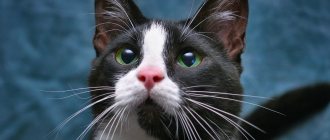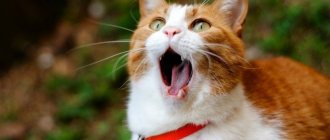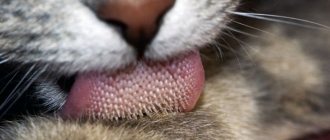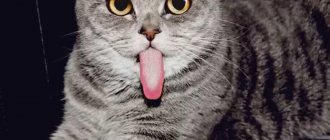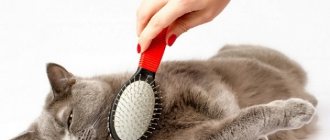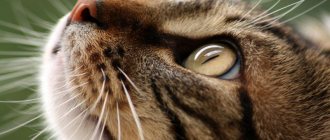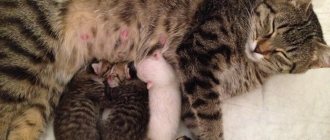The cat's tongue is a multifunctional, natural organ, the properties of which greatly influence the cat's life. Discrimination of tastes, thermoregulation, toilet/hygienic procedures are its main functions. At the same time, aimless display of it in cats, unlike dogs, is not accepted; this is their internal “wealth”. The material provides brief answers to the question “why and why do all cats have a rough tongue?”
My tongue is my wealth. I'll show you as much as I want.
What should a cat's tongue be like?
The cat's tongue, an organ that is multifunctional in its properties, is distinguished by roughness caused by the presence of capillary papillae on the skin of the cat's tongue - keratinized sharp protrusions located right up to the animal's larynx.
The tongue of a cat is quite long; in a calm state it is flat and very mobile. This feline taste organ consists of muscle tissue and a mucous membrane covering it.
The color of a cat's tongue changes depending on its condition. In a healthy cat it is always pink, and a change in color indicates problems in its health.
Nature itself took care of the neat people, which are all representatives of the cat family - they are extremely clean, for this reason regular grooming (licking) is included in their daily routine.
Tongue of a healthy cat
The danger of a cat’s special tongue structure
If a pet accidentally swallows or eats excessively hot food, a burn to the mucous membrane is possible, due to which the surface of the tongue will level out and acquire a scarlet tint.
The special structure of the organ does not allow the pet to independently get rid of the eaten tinsel.
The keratinized capillary projections are often caught by threads, fur or small objects that have entered the animal's oral cavity. Due to the fact that the papillae are directed into the throat, the pet cannot cough up garbage and tries to swallow it. As a result, inedible objects accumulate in the cat's gastrointestinal tract. Some of them come out along with vomiting, which is artificially induced by the animal, but the consequence can be intestinal obstruction and open wounds in the stomach. New Year's tinsel is especially dangerous for cats.
If the owners notice the remains of jewelry in the animal’s mouth, veterinarians prohibit dragging them onto themselves, since there is a high risk of damaging the pharynx and esophagus. It is better to cut off the protruding piece and cause diarrhea in your pet. To do this, you can use fats of animal and vegetable origin, for example, 1/3 tsp. sunflower oil or 1.5 tbsp. l. Vaseline. You should also take your cat to the doctor, as surgery may be required.
Main functions
So, why is a cat's tongue rough? In the wild, it was the keratinized spines that appeared on their tongues as a result of evolution that made it easier for predator cats to eat.
The language for cats is a kind of:
- "fork"
- "spoon"
- "knife"
- "comb"
- "shower"
- "air conditioner"
- health test substitute
The keratinized projections on the cat's tongue ensure that it performs various functions:
- make it easier for cats to perform their specific ritual of washing - licking fur (grooming);
- ensure food intake and make it easier to eat meat and fish located in hard-to-reach places;
- help scoop and hold liquid before swallowing;
- signal a change in the cat's health:
- a black tongue is evidence of vitamin deficiency;
- the white color of the tongue indicates problems with the functioning of her digestive system;
- pale brown and gray color indicate problems with the respiratory system;
- yellow coating on a cat’s tongue is a signal of problems with the liver or kidneys;
- an unnaturally pale tongue is evidence of a malfunction in the animal’s cardiovascular system.
What a pleasure to drink when you are thirsty!
Care tool
Cats are famous tidy people. Scientists have calculated that one cat spends approximately 2.5 hours per day using its rough tongue as a “brush with soap.”
I, unlike some, don’t stick my tongue out for no particular reason.
Source of taste impressions
The cat's tongue is the most important organ of taste for these rather picky eating animals. With their rough tongue, which has super-sensitive receptors, cats determine the texture of food and whether it is too hot for them.
Natural "refrigerator"
The cat's tongue also has the ability to regulate body temperature. Representatives of the Technological University (Georgia, USA), concerned with the study of the mechanism of “work” of the cat’s tongue, came to the following results (according to the journal Science).
Ensuring hygiene for yourself and your offspring is not the only property of a rough cat’s tongue. In hot weather conditions, the specific structure of the cats' tongue comes to the rescue. During the process of licking, the liquid contained in the specific papillae of their tongue significantly lowers their body temperature.
Using computed tomography, American researchers found that the specific papillae present on the tongues of cats have different sizes. Those located in the center of the tongue are smaller in size than the papillae located on the sides. It is the lateral papillae of the tongue that play a greater role in licking. These scientists also established the fact that as a result of licking, a cat’s body cools by about 25%, making it difficult for them to overheat.
In extreme heat or when there is excessive stress, the animal breathes often, sticking out its tongue, this also helps to cool the body.
Licking each other as an indicator of empathy
Empathy, as empathy for the current psycho-emotional state of another, is inherent in cats to a sufficient extent: by licking another cat/another animal, a cat shows its emotional attachment and care.
I'm always happy to help, it's not for nothing that I was given such a tongue
It is quite rare for a cat to lick a person's face. However, if this happens, a person should not be “rude” to the cat or push it away, as this may harm its feelings. After all, by doing this, she clearly demonstrates to you that she cares. The serious sensory and emotional potential that cats have, they can (should not!) reveal in relation to those people with whom they live. Felinologists have found that cats' feelings and emotions are quite comparable to the feelings and emotions of people. The ability to empathize is one of the answers to the question: why does a cat have a rough tongue? In order to indicate to a person your feelings, to draw attention to yourself, because it is hardly possible not to notice his specific touch.
We are also capable of showing empathy, sympathy and antipathy.
Feel
Why do cats have rough tongues? Because it is dotted with papillae. But this not only gives the animal additional positive characteristics. It also increases the sensitivity of the tongue. If a cat injures its tongue for any reason, then this pain will exceed the sensations that the cat would experience if another part of the body was injured. The tongue turns out to be much more sensitive than the paw, tail or ear.
By the way, due to the fact that the cat has a rough tongue, its teeth always remain clean and sharp.
In addition, due to the peculiarities of the tongue, cats provide themselves with the function of thermoregulation. You've probably often noticed that during hot weather, your pet sticks its unit out. She does this to evaporate excess moisture from the body, since the cat does not have sweat glands that provide this. This way the pet lowers its body temperature.
Structural features and functionality
Cats are very neat animals. Regardless of how thick and long their coat is, it always has a neat and well-groomed appearance. If you observe your pet, you will notice that he thoroughly washes himself and licks his fur several times a day. The roughness of the tongue plays an important role in such care.
This organ is a natural comb for a cat. This effect is achieved due to the keratinized papillae on its surface, directed towards the pharynx. Their appearance resembles hooks. On top, such points are covered with a layer of keratin, which is what human nails are made of. For this reason, the animal's display of love, when it diligently licks its owner, can cause discomfort and even pain, because the thin “hooks” scratch the skin like sandpaper.
Skillfully using this part of their body, pets remove lost hair, parasites, debris and comb out stray hairballs. In addition, such growths on the surface of the tongue allow the animal to better separate meat from bones during a meal.
Interesting fact: Thanks to this peculiarity of the structure of the tongue, cats sense the taste of food better than other animals. The “hooks” on it hold food in the mouth, which allows you to feel its taste.
The shape of a cat's tongue resembles a spoon, which is why it is so easy for representatives of the cat family to lap up liquid food. It also serves as a heat dissipator. In extreme heat, cats stick out their tongues and begin to breathe rapidly. This is how they cool their body.
By the way, dogs have a completely different tongue, its surface is smooth. These animals do not groom themselves; they are looked after by breeders and owners.
The structure of the tongue and feeding habits of cats
Due to the constant need to maintain a cat's image, the structure of the tongue has undergone significant changes in the process of evolution.
This muscular organ, on its surface, has many keratinized papillae, which are curved towards the animal’s esophagus. The tongue is extremely rough to the touch, so it reminds some people of sandpaper. Therefore, the affection of a domestic cat is sometimes very strongly felt by its owner. The special structure of this muscular organ gives it many functions necessary for the life of cats.
All members of the cat family are predators, even cute domestic cats. It is not surprising that the most desired dish for these creatures is meat. Often cats want to eat the remains of meat from the bone, and the special structure of the tongue again helps to fulfill this desire.
We suggest you read: How to treat scratching on a cat’s neck. Treatment of skin diseases in cats with photos
With the help of this organ, as if using sandpaper, you can very carefully remove all, even hard-to-reach, pieces of meat.
If you pay attention to how a cat drinks liquid, you may be very surprised at how deftly and quickly the animal sends drops of moisture into the esophagus. This ability is also provided by the structure of the tongue. It is the roughness of this organ that helps drops of liquid, accumulating on its surface, not to roll back, but to enter the stomach.
In the wild, representatives of this family prefer to hunt for prey. After the hunted object is caught, it needs to be butchered. During this operation, sometimes cats lack claws and teeth, then the tongue comes to the rescue. Its hard surface makes it possible to cope with the skin or feathers of prey, more thoroughly separate it and get to hard-to-reach but desirable pieces of meat.
Let's watch the cat
A cat is a very neat animal; it always keeps its fur in order. Observe her behavior. Before curling up into a cozy ball, a cat will certainly groom its fur, wash its face with its paw and its tongue plays the most important role in this matter.
Natural comb for cats
Its entire surface is covered with small points that resemble hooks. They are directed towards the pharynx, covered with keratin (our nails are made of this substance). That is why, by licking you, showing its love and tenderness, a cat can cause minor pain, discomfort, small hooks scratch like sandpaper. This quality of a cat's tongue can be compared to the action of a comb. Just as a person combs and smoothes his hair, a cat performs similar actions with its tongue.
Cats are given the opportunity to carefully care for their fur, which cannot be said about dogs; they do not have such sharp hooks on their tongues, they are not able to untangle tufts of fur. It is worth noting that although cats have such an effective grooming tool, they do not always use it. Very often, lazy cats, overweight cats, sick animals, or simply spoiled, self-satisfied specimens do not bother to lick all areas of the body. They often leave this work to their owners.
If you have already taken on the responsibility of a cat caretaker, then carefully inspect the fur to avoid the formation of stray lumps (tangles).
